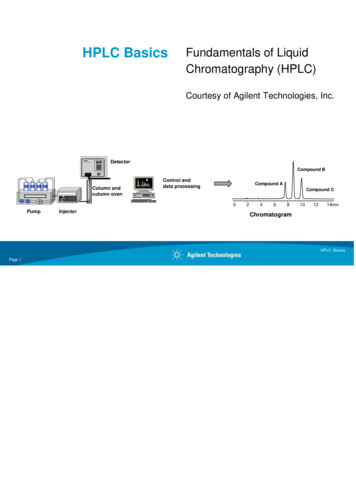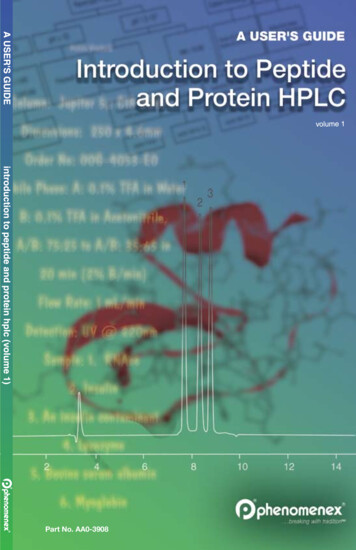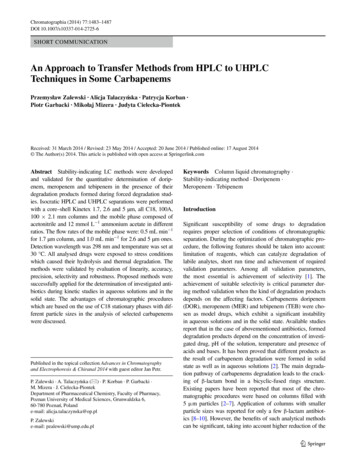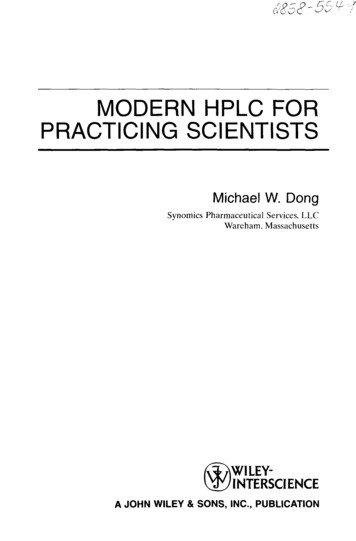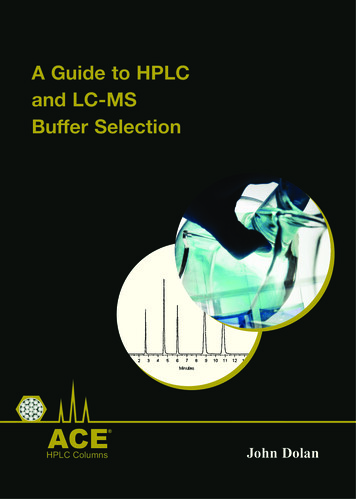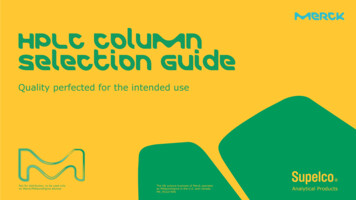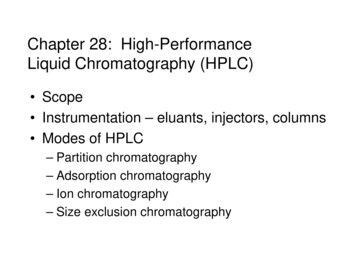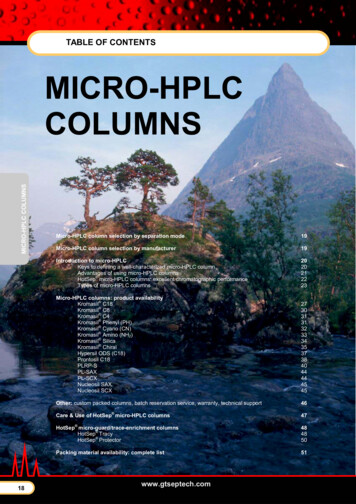
Transcription
TABLE OF CONTENTSMICRO-HPLC COLUMNSMICRO-HPLCCOLUMNS18Micro-HPLC column selection by separation mode19Micro-HPLC column selection by manufacturer19Introduction to micro-HPLCKeys to defining a well-characterized micro-HPLC columnAdvantages of using micro-HPLC columnsHotSep micro-HPLC columns: excellent chromatographic performanceTypes of micro-HPLC columns2020212223Micro-HPLC columns: product availabilityKromasil C18Kromasil C8Kromasil C4Kromasil Phenyl (PH)Kromasil Cyano (CN)Kromasil Amino (NH2)Kromasil SilicaKromasil ChiralHypersil ODS (C18)Prontosil C18PLRP-SPL-SAXPL-SCXNucleosil SAXNucleosil SCX273031313233343537384044444545Other: custom packed columns, batch reservation service, warranty, technical support46Care & Use of HotSep micro-HPLC columns47HotSep micro-guard/trace-enrichment columnsHotSep TracyHotSep Protector484850Packing material availability: complete list51www.gtseptech.com
MICRO-HPLC COLUMN SELECTIONMicro-HPLC Column Selection by Separation ModeAdsorption ChromatographyKromasil Silica34Chiral ChromatographyKromasil CHI-TMBKromasil CHI-TBB3535Ion-exchange ChromatographyNucleosil SAXNucleosil SCXPL-SAXPL-SCX45454444Normal Phase ChromatographyKromasil SilicaKromasil Amino (NH2)3433Reversed-Phase ChromatographyKromasil C18Kromasil C8Kromasil C4Kromasil Phenyl (PH)Kromasil Cyano (CN)Kromasil Amino (NH2)Hypersil ODSProntoSIL C18HPLRP-S273031313233373840This selection is, neither in terms of manufacturers nor in terms of their products, a complete list, and theaccuracy of the data is not guaranteed.Column:G&T Septech Replacement(s)Silica:Polymer:Agilent TechnologiesZorbax Eclipse-XDB C18 100Zorbax Eclipse-XDB C8 100Zorbax Eclipse-XDB C18 300Zorbax SB C18 100Zorbax SB C8 100Zorbax SB Cyano 100Kromasil C18 100Kromasil C8 100Kromasil C18 300, ProntoSIL C18 300Kromasil C18 100Kromasil C8 100Kromasil Cyano 100PLRP-S 100Grace-VydacDenali 120Everest 300Kromasil C18 100Kromasil C18 300, ProntoSIL C18 300PLRP-S 100PLRP-S 300Higgins AnalyticalClipeus C18Clipeus C8Kromasil C18, ProntoSIL C18Kromasil C8PLRP-SLC PackingsPepMap C18 100PepMap C18 300Kromasil C18 100Kromasil C18 300, ProntoSIL C18 300PLRP-S 100PLRP-S 300Micro-Tech ScientificMicrosil C18 300Kromasil C18 300, ProntoSIL C18 300PLRP-S 300PhenomenexJupiter 300Luna C18 100Luna C8 100Kromasil C18 300, ProntoSIL C18 300Kromasil C18 100Kromasil C8 100PLRP-S 300PLRP-S 100WatersSymmetry C18 100Symmetry C8 100Symmetry C18 300X-Terra C18 100X-Terra C18 300Kromasil C18 100Kromasil C8 100Kromasil C18 300, ProntoSIL C18 300Kromasil C18 100Kromasil C18 300, ProntoSIL C18 300PLRP-S 100www.gtseptech.comMICRO-HPLC COLUMNSMicro-HPLC Column Selection by ManufacturerPLRP-S 300PLRP-S 100PLRP-S 300PLRP-S 100PLRP-S 30019
INTRODUCTION TO MICRO-HPLCIntroduction to micro-HPLCMicro-HPLC plays a crucial role in the modern laboratory by expanding the boundaries of conventionalHPLC. Today micro-HPLC is used more or less on routine basis for a wide range of applications rangingfrom biotechnology to environmental analysis, e.g. peptide mapping by capLC-ESI-MS or analysis ofimportant low-abundant metabolites in plasma.Keys to defining a “well-characterized” micro-HPLC column by traditional HPLC terms are:MICRO-HPLC COLUMNSSelectivityThe micro-HPLC column must be able to separatethe target compound(s) from other compoundspresent, e.g. to monitor synthetic products suchas peptides or oligonucleotides for identity andpurity by separating important impurities frommajor products. Resolving minor impurities suchas deamidation products or oxidized methioninevariants place the strongest demands on microHPLC column selectivity. In such cases, wherehigh resolution between major product andimpurities seldom is obtained, high columnefficiency plays a crucial role for achievingsufficient resolution.Furthermore, in situations where the totalsample amount is too small to allow detection oftarget compounds (e.g., important impurities ormetabolites) with conventional HPLC instruments,the use of a micro-HPLC instrument is anecessity. Such an example is shown in Appl.Note 134.ReproducibilityMicro-HPLC column selectivity and efficiencyshould remain the same when used microcolumns are replaced with new ones. A bigadvantage of micro-HPLC columns is that severalthousands columns can be made from the samebatch of packing material, which eliminateproblems with “batch-to-batch”-variations. Appl.Note 135 shows three 3.5µ Kromasil C18 100 Å(0.3 x 150 mm) columns packed and tested over aperiod of 2 years, which clearly illustrates the highmicro-HPLC column reproducibility achievable.StabilityAlthough the robustness of micro-HPLC columnscannot match the robustness of their big brothers,the selectivity and efficiency must be constantover numerous injections to ensure robust andreliable assays. Only micro-HPLC columns whichare physically and chemically stable and whichmaintain their chromatographic properties overcertain period of time are acceptable for methodsused on routine basis. By proper samplepreparation and the use of guard columns/columnswitching, micro-HPLC columns can last forseveral hundreds injections (Appl. Note 136).20www.gtseptech.com
INTRODUCTION TO MICRO-HPLC (cont.)Advantages of using micro-HPLC columnsImproved Limit of Detection!When only limited sample amounts are availablefor analysis, HotSep micro-HPLC columns offerlower limits of detection (LOD) when connected toconcentration-sensitive detectors such ESI-MS orwhen post-column flow-splitting is applied. Forexample, a 0.5 mm ID column gives 85x lowerLOD than a 4.6 mm ID column. In manyapplications, the sample amount is simply toosmall to be detected with conventional HPLCinstruments.chromatography, e.g. preheating of the mobilephase is simplified or often unnecessary. Highercolumn temperatures increase the mass transferrate, thereby improving column efficiency and, ingeneral, peaks are sharpened and resolutionimproved. Higher temperatures usually givereduced retention and thus less organic modifieris required, and the analysis can often beperformed at a higher volumetric flow rate with noloss in resolution.Reduced Column Length – Faster SeparationsHotSep micro-HPLC columns offer a drasticreduction in organic solvents consumptioncompared to conventional sized HPLC columns.For example, a 1.0 mm ID column will reduce themobile phase waste by a factor of 21 comparedwith a standard 4.6 mm ID column.High-Temperature CompatibilityThe low thermal mass of micro-HPLC columns isideal for exploiting temperature to modulate theMany separations can be performed on shortercolumns and higher flow-rates without sacrificingthe baseline resolution. Furthermore, when usinghighly selective detectors such as the MSbaseline resolution is often not required. However,being able to separate the analyte(s) from thevoid volume/matrix is preferred, especially whenanalysing complex matrixes such as biologicalsamples, due to possible suppression effects inthe ion source. The HotSep micro-HPLCcolumns are therefore offered in 3 cm length for3µ particles and 5 cm length for 5µ particles. Suchshort narrow-bore columns offer extremely lowsolvent consumption per analysis.www.gtseptech.comMICRO-HPLC COLUMNSReduced Waste21
INTRODUCTION TO MICRO-HPLC (cont.)Excellent Chromatographic Performancebasic and neutral molecules. The HotSep columns are supplied with stainless steel screensor titanium frits to ensure high biocompatibility.HotSep micro-HPLC column facts: Fully Validated Columns High Reproducibility High RobustnessMICRO-HPLC COLUMNS More than 100.000 plates/m on routine basisOur packing procedures enable us to pack theHotSep micro-HPLC columns with highefficiency. For example, we routinely obtain80,000 - 90,000 and 100,000 - 130,000 plates/mon columns packed with 5m Kromasil C18 and3.5m Kromasil C18, respectively.Column ValidationWe guarantee that each column is carefullyexamined and tested before it leaves us. Thecolumns are tested in a commercially availablemicro-HPLC system to insure that you as acustomer can reproduce our results. Each columnis delivered with a Certificate of Analysis showingthe test results.The HotSep range of micro-HPLC columns arepacked with materials from leading reputablemanufacturers of stationary phases on themarket. A wide range of bonding chemistriescombined with ultra-pure silica particles providesexcellent chromatographic performance for acidic,22www.gtseptech.com
INTRODUCTION TO MICRO-HPLC (cont.)Types of micro-HPLC columnsabColumnID(mm)ColumnCategoryFlow RateRange(µL/min)OptimumFlow Rate(µL/min)aAnalyteCapacitybRequired Amountof Pept./Proteins(fmole)Bed volume15 cm column(µL)1.0microbore20-20035 10 µg 1,0001200.5vapillary5-508 2.5 µg 250300.3capillary2-203 1 µg 100100.1nano0.25-2.50.5 100 ng 1020.075nano0.1-10.3 25 ng 10.7For true low dead-volume systemsBased on 3.5µ Kromasil C18 100ÅTypical flow rates:1.0 mm ID: 30 - 50 µL/minWetted parts:quartz, stainless steel 316End fittings:female 1/16” connections in both endsMicrobore HPLC columns offer a convenientcompromise between sensitive capillary columnsand highly robust conventional-bore columns. A1.0 mm ID column provides more than a twentyfold increase in sensitivity over a 4.6 mm IDcolumn when injecting the same amount (mass)of sample (Appl. Note 134). This increase insensitivity can be critical for accuratequantification of sample limited applications.Moreover, the solvent waste is markedly reduced,offering a greener environment in the laboratoryand economical benefits when using expensivesolvents.The HotSep microbore columns provide highefficiencies and are available with a variety ofpackings. The columns are packed in robust 1/8”O.D. glass-lined stainless steel tubing offeringsmooth internal surface with high biocompatibilityand the possibility of operating the column atelevated temperatures. Standard 1/16” end fittingsprovide simple, universal and robust connections.HotSep capillary columns (0.5 and 0.3 mm ID)MICRO-HPLC COLUMNSHotSep microbore columns (1.0 mm ID)Capillary HPLC columns offer high sensitivity dueto their low dispersion characteristics. Forexample, a 0.3 mm ID column provides about200-fold increase in sensitivity over a 4.6 mm IDcolumn when injecting the same amount (mass)of sample. The analytes elute in smaller peakvolumes, resulting in higher response e, ESI-MS). This increase in sensitivityis often a necessity for accurate quantification ofsample limited applications.The HotSep capillary HPLC columns are idealfor use with detectors requiring very low flowrates, such as ESI-MS. This feature, combinedwith low dispersion characteristics, has led to asteadily increasing acceptance of such columns inapplications where limited sample amounts leadto problems in detection sensitivity. This isrelevant in the areas of pharmacokinetics, traceanalysis and in particular the expanding fields ofbioanalytical and proteomic analysis.www.gtseptech.com23
INTRODUCTION TO MICRO-HPLC (cont.)The HotSep capillary HPLC columns providehigh efficiencies and are available with a variety ofpackings. The capillary columns are packed inrobust glass-lined stainless steel. Standard 1/16”end fittings provide simple, universal and robustconnections.Typical flow rates:0.3 mm ID: 3 - 5 µL/min0.5 mm ID: 8 - 10 µL/minMICRO-HPLC COLUMNSWetted parts:quartz, stainless steel 316End fittings:female 1/16” connections (1/32” is optional) inboth endsHotSep nano-HPLC columns (100 and 75 µm)The HotSep nano-HPLC columns offer ultra-highsensitivity due to their low dispersioncharacteristics. A 75 µm I.D. column provides a3760-fold increase in sensitivity over a 4.6 mmI.D. column when injecting the same amount(mass) of sample. The analytes elute in smallerpeak volumes, resulting in higher response e, ESI-MS). This increase in sensitivityis often a necessity for accurate quantification ofsample limited applications.Typical flow rates:100 µm ID: 0.3 - 1 µL/min75 µm ID: 0.2 – 0.5 µL/minWetted parts:fused silica, stainless steel 316Nano-HPLC combined with nano-ESI-MS is thecutting-edge technology within miniaturizedseparation techniques and it is rapidly becoming24the dominating analysis tool within proteomics/peptidomics. The HotSep nano-HPLC columnsprovide high efficiencies and reproducibility andthey are available with a variety of packings. Thecolumns are packed in PEEK-coated fused silicacapillaries (PEEK-SIL), which are flexible androbust for practical use. Standard 1/16” endfittings provide simple, universal and robustconnections.End fittings:female 1/16” (1/32” is optional) connections inboth ends.www.gtseptech.com
KROMASIL PACKINGSKromasil Kromasil (EKA Chemicals) has superior mechanical and chemical stability, high surface area and narrowpore size distribution. The combination of high pore volume/surface area and high mechanical stabilitymakes this material unique compared to other materials on the market. In addition the surface propertiesare excellent, making it possible to run even basic compounds without the addition of additives. Extensivecontrol and testing are performed throughout the whole production process, ensuring the highest possiblereproducibility.Introduction to Kromasil packingsKromasil silica-based packings are designed tomeet the highest demand in HPLC and SFC fromnano to process scale. The uniqueness ofKromasil high-performance spherical silica is thecombination of:MICRO-HPLC COLUMNS high surface area mechanical strengthOther outstanding properties are: Kromasil 3.5µchemical puritychemical stabilityoptimized surface propertieswell-defined pore structureKromasil HPLC silica consists of perfectlyspherical, totally porous particles. They areproduced in sizes of 3.5–16µ and with a narrowparticle size distribution for high efficiency, lowpressure drop and best total economy inchromatographic separations.The pictures to the right show SEM photographsof Kromasil 3.5µ and 10µ.Kromasil 10µSpecifications: Kromasil PORESIZE (Å)SURFACEAREA(m2/g)1.5–9.5100, 300330, 12020% C, 8.7% C1.5–9.5100, 300330, 12012% C, 4.7% C3.5, 5, 101.5–9.5100, 300330, 1208% C, 2.9% C51.5–9.5100330-yes51.5–9.56053012% C, 2.3% Nyes3.5, 51.5–9.51003301.9% NNPno3.5, 51.5 – 9.5100330-CHI-DMBchiralyes51.5–9.510033015% C, 0.6% NCHI-TBBchiralyes51.5–9.510033015.5% C, 20.6% NMODEENDCAPPEDPARTICLESIZE (µm)C18RPyes3.5, 5, 10C8RPyes3.5, 5, 10C4RPyesPhenylRPyesCyano (CN)RP/NPAmino (NH2)RP/NPPHASESilicapHRANGECOVERAGERecommended maximum temperature for all Kromasil materials is 50oC.CHI-DMB:CHI-TBB:O,O'-bis (3,5-dimethylbenzoyl)-N,N'-diallyl-L-tartar diamideO,O'-bis (4-tert-butylbenzoyl)-N,N'-diallyl-L-tartar diamidewww.gtseptech.com25
KROMASIL PACKINGSCHROMATOGRAPHIC PROPERTIES OF KROMASIL REVERSED-PHASE COLUMNSHydrophobicityMICRO-HPLC COLUMNSHydrophobicity determines the separation powerof HPLC materials when hydrophobic interactionsare dominating. High surface coverage and typeof ligand influence this parameter. How retentionis influenced by the stationary phasehydrophobicity, is shown in Figure below.Metal impurities in the stationary phaseMetal impurities in the silica structure affect theacidity of silanols, creating non-homogeneousstructures which strongly complex with chelatingcompounds. For this reason, metal impuritiesmust be carefully monitored in silica-basedmaterials. In Figure below, the content of metalimpurities of Kromasil and other commercialmaterials is shown.Ion-Exchange PropertiesThe interaction of basic samples with acidicsilanols is mainly an ion exchange process. Thesestrong interactions may cause undesired tailingwhen separating basic compounds, such astricyclic antidepressants, on reversed-phasematerials. To illustrate this, the separation of amixture of tricyclic antidepressants (with tolueneas a neutral reference), is shown for Kromasil C18and analogous commercial materials (see Figure).As shown, Kromasil materials are ideal forseparations of basic compounds.!!! Development, production and marketingof Kromasil packings are ISO 9001 certified.26www.gtseptech.com
KROMASIL C18Kromasil C18USP COLUMN CLASSIFICATION: L1 one of the world’s most popular reversed-phase HPLC materials! High efficiency 3.5µ particles available – identical bonding to 5µ Very high loading capacity Excellent chemical and mechanical stability High retentivity Separation of basic compounds without additives :yesyesParticle size:3.5 and 5µ5µpH-stability:1.5-9.51.5-9.5Actual pore size:110 25Å300 25ÅSurface area:330 m2/g120 m2/gPore volume:0.9 mL/g-Mechical stability:700 barsCarbon load:MICRO-HPLC COLUMNSSpecifications:400 bars220%, 3.5 µmol/m8%Recommended max. temperature with aqueous mobile phases is 50oC.www.gtseptech.com27
MICRO-HPLC COLUMNSKROMASIL C18 (cont.)28www.gtseptech.com
KROMASIL C18 (cont.)ORDERING INFORMATION – HOTSEP KROMASIL C183.5µ - 100Å COLUMNSIDSMALL MOLECULES (MW 100 – 5,000)3 cm5 cm10 cm15 cmGuardGuard/5pk1.0 -1G-111-10-50.5 -1G-111-05-50.3 -1G-111-03-50.1 mm------P-111-0110P-111-0115------75 µm------P-111-00710P-111-00715------5 cm10 cm15 cm25 cmGuardGuard/5pk1.0 -1G-121-10-50.5 -1G-121-05-50.3 -1G-121-03-50.1 mm---P-121-0110P-121-0115---------75 µm---P-121-00710P-121-00715---------5 cm10 cm15 cm25 cmGuardGuard/5pk1.0 -1G-128-10-50.5 -1G-128-05-50.3 -1G-128-03-50.1 mm---P-128-0110P-128-0115---------75 µm---P-128-00715P-128-00715---------5µ - 100Å COLUMNSIDSMALL MOLECULES (MW 100 – 5,000)IDMEDIUM MOLECULES (MW 500 – 25,000)MICRO-HPLC COLUMNS5µ - 300Å COLUMNSCustom dimensions are available upon requestwww.gtseptech.com29
KROMASIL C8Kromasil C8USP COLUMN CLASSIFICATION: L7 excellent alternative to C18 phases whenretention is unnecessary high! High efficiency 3.5µ particles available – identical bonding to 5µ Excellent chemical and mechanical stability Lower retentivity than Kromasil C18 (p. 27), less organic modifierrequiredMICRO-HPLC COLUMNS Separation of basic compounds without additives yesParticle size:3.5 and 5µpH-stability:Actual pore size:1.5-9.5110 25ÅSurface area:330 m2/gPore volume:0.6 mL/gMechical stability:700 barsCarbon load:12%, 3.7 µmol/m2Recommended max. temperature with aqueous mobile phases is 50oC.30www.gtseptech.com
KROMASIL C8 (cont.)ORDERING INFORMATION – HOTSEP KROMASIL C83.5µ - 100Å COLUMNSIDSMALL MOLECULES (MW 100 – 5,000)3 cm5 cm10 cm15 cmGuardGuard/5pk1.0 -1G-112-10-50.5 -1G-112-05-50.3 -1G-112-03-50.1 mm------P-112-0110P-112-0115------75 µm------P-112-00710P-112-00715------5µ - 100Å COLUMNSIDSMALL MOLECULES (MW 100 – 5,000)10 cm25 cmGuardGuard/5pkS-122-1005S-122-1010S-122-101515 cmS-122-1025G-122-10-1G-122-10-50.5 -1G-122-05-50.3 -1G-122-03-50.1 mm---P-122-0110P-122-0115---------75 µm---P-122-00710P-122-00715---------5µ - 300Å COLUMNSIDMEDIUM MOLECULES (MW 500 – 25,000)5 cm10 cm15 cm25 cmGuardGuard/5pk1.0 -1G-129-10-50.5 -1G-129-05-50.3 -1G-129-03-50.1 mm---P-129-0110P-129-0115---------75 µm---P-129-00710P-129-00715---------MICRO-HPLC COLUMNS5 cm1.0 mmCustom dimensions are available upon request!!! Kromasil is also available with a C4 phase and a Phenyl phase. Both phases are usually less retentive thanKromasil C8, but the Phenyl phase often has slightly different selectivity and is completely wettable in 100 %aqueous eluents. For ordering information, please refer to p. 51 for correct material codes.www.gtseptech.com31
KROMASIL CYANOKromasil Cyano (CN)USP COLUMN CLASSIFICATION: L10 High efficiency 3.5µ particles available – identical bonding to 5µ Excellent chemical and mechanical stability Lower retentivity than Kromasil C18 (p. 27), less organic modifierrequiredFor carboxyl, carbonyl, and amine containing compounds, Kromasil CN offers unique polar selectivity in RP and NP mode.MICRO-HPLC cle size:pH-stability:Actual pore size:Surface area:Pore volume:Mechical stability:Carbon load:CyanopropylRP/NPyes5µ1.5-9.580 15Å530 m2/g1.2 mL/g700 bars12% C, 2.3% NRecommended max.temperature withaqueous mobile phasesis 50oC.ORDERING INFORMATION – HOTSEP KROMASIL CYANO5µ - 60Å COLUMNSIDSMALL MOLECULES (MW 100–5,000)5 cm10 cm15 cm25 cmGuardGuard/5pk1.0 -1G-124-10-50.5 -1G-124-05-50.3 -1G-124-03-5Custom dimensions are available upon request32www.gtseptech.com
KROMASIL AMINOKromasil Amino (NH2)USP COLUMN CLASSIFICATION: L8 Ideal for separation of simple and complex sugars, sugar alcohols or otherhydrogen-bonding compounds under RP or NP mode Stable in 100% aqueous mobile phases No anomer resolution in sugar analysisSpecifications:AminopropylRP/NPyes3.5µ and 5µ1.5-9.580 25Å330 m2/g0.9 mL/g700 bars1.7% NRecommended max.temperature withaqueous mobilephases is 50oC.MICRO-HPLC COLUMNSLigand:Mode:Endcapping:Particle size:pH-stability:Actual pore size:Surface area:Pore volume:Mechical stability:Carbon load:ORDERING INFORMATION – HOTSEP KROMASIL AMINO3.5µ - 100Å COLUMNSIDSMALL MOLECULES (MW 100–5,000)3 cm5 cm10 cm15 cmGuardGuard/5pk1.0 -1G-113-10-50.5 -1G-113-05-50.3 -1G-113-03-55µ - 100Å COLUMNSIDSMALL MOLECULES (MW 100–5,000)5 cm10 cm15 cm25 cmGuardGuard/5pk1.0 -1G-123-10-50.5 -1G-123-05-50.3 -1G-123-03-5Custom dimensions are available upon requestwww.gtseptech.com33
KROMASIL SILICAKromasil SilicaUSP COLUMN CLASSIFICATION: L3 High surface area and mechanical strength Low metal content and well defined pore structure Base particle of all other Kromasil phasesSpecifications:NP3.5µ and 5µ1.5-9.580 25Å330 m2/g0.9 mL/g700 barsMICRO-HPLC COLUMNSMode:Particle size:pH-stability:Actual pore size:Surface area:Pore volume:Mechical stability:ORDERING INFORMATION – HOTSEP KROMASIL SILICA3.5µ - 100Å COLUMNSIDMW 100 – 5,0003 cm5 cm10 cm15 cmGuardGuard/5pk1.0 -1G-117-10-50.5 -1G-117-05-50.3 -1G-117-03-55µ - 100Å COLUMNSIDMW 100 – 5,0005 cm10 cm15 cm25 cmGuardGuard/5pk1.0 -1G-127-10-50.5 -1G-127-05-50.3 -1G-127-03-5Custom dimensions are available upon request34www.gtseptech.com
KROMASIL CHIRALKromasil ChiralSelected Applications on Kromasil CHI-TMBand CHI-TBBSeparation Factor (α)CHI-TMBCHI-TBB Chiral network polymers covalently bonded tosilica Two phases offer complementary enantioselectivity Good selectivity for acidic and basic chiralcompounds Good loadability and good mechanical andchemical stabilityChiral SelectorsTwo phases have been developed to compliment eachother in selectivity:Kromasil CHI-TMBThe chiral monomer is O,O'-bis (3,5-dimethylbenzoyl)N,N'-diallyl-L-tartar diamide.Kromasil CHI-TBBThe chiral monomer is O,O'-bis (4-tert-butylbenzoyl)N,N'-diallyl-L-tartar diamide.The chiral monomers are reacted with a mulrifunctional hydrosilane yielding a network polymerincorporating the bifunctional C2-symmetric chiralselector. The chiral polymer is then covalently bondedto functionalized silica.PerformanceThe Kromasil Chiral phases separate a broad rangeof racemates (see Table). The phases are based 5µparticles to give sharp peaks for best possibleresolution. As with most chiral columns, the bestselectivity is obtained under normal phase conditions,however these phases are equally usable and stableaqueous conditions.Mechanical and Chemical StabilityThe Kromasil Chiral phases are one of the mostmechanically stable of HPLC silicas. The high stabilityis given by the nature of the network polymercovalently bonded to the silica. Both phases can beused with most solvents and buffers in the mobilephase without degradation. TFA buffers can, undercertain conditions, cause some hydrolysis of fenBenoxaprofenPriprofenBenzithiadiazines andRelated ---Amino Bi-(2-naphtol)2-(Octylsulfinyl)-benz. C COLUMNSBase SilicaSince the surface properties of the silica have a greatimpact on the enantioselectivity of chiral stationaryphases, Kromasil Chiral is made high purity, uniformsurface Kromasil premium amKetazolamCamazepamTemazepamLoadabilityKromasil Chiral phases have a high loadingcapacity compared to other chiral phases. Thisis due to the high surface area of the silica andthe high chiral ligand density.www.gtseptech.com35
MICRO-HPLC COLUMNSKROMASIL CHIRAL (cont.)!!! Check previous page for a list of applications on Kromasil CHI-TMB and Kromasil CHI-TBBORDERING INFORMATION – HOTSEP KROMASIL CHI-TMB5µ - 100Å COLUMNSIDMW 100–5,0005 cm10 cm15 cm25 cmGuardGuard/5pk1.0 -1G-125-10-50.5 -1G-125-05-50.3 -1G-125-03-5ORDERING INFORMATION – HOTSEP KROMASIL CHI-TBB5µ - 100Å COLUMNSIDMW 100–5,0005 cm10 cm15 cm25 cmGuardGuard/5pk1.0 -1G-126-10-50.5 -1G-126-05-50.3 -1G-126-03-5Custom dimensions are available upon request36www.gtseptech.com
HYPERSIL ODSHypersil ODS (C18)USP COLUMN CLASSIFICATION: L1 Slightly different selectivity than modern C18 phases when separating amines Not recommended for highly basic compoundsHypersil ODS (Thermo Hypersil-Keystone) is a classical and well-knownreversed-phase material for experienced users of HPLC. This material isend-capped, but not well deactivated and may give interactions betweenthe analytes and the silanols on the stationary phase. Hence, it may provide a slightly different selectivity than Kromasil C18. Not recommended forhighly basic compounds.Ligand:Mode:Endcapping:Particle size:pH-stability:Actual pore size:Surface area:Carbon Load:C18reversedyes3µ2-8120Å170 m2/g10% CMICRO-HPLC COLUMNSSpecifications:Recommended max.temperature withaqueous mobile phasesis 50oC.ORDERING INFORMATION – HOTSEP HYPERSIL ODS3µ - 100Å COLUMNSIDSMALL MOLECULES (MW 100–5,000)3 cm5 cmGuardGuard/5pk1.0 mmS-151-1003S-151-1005S-151-101010 cmS-151-101515 cmG-151-10-1G-151-10-50.5 -1G-151-05-50.3 -1G-151-03-50.1 mm------P-151-0110P-151-0115------75 µm------P-151-00710P-151-00715------Custom dimensions are available upon requestwww.gtseptech.com37
PRONTOSIL C18ProntoSIL C18USP COLUMN CLASSIFICATION: L1.excellent high-purity silica-based reversed-phase material forseparation of biomoleculesMICRO-HPLC cle size:pH-stability:Act. pore size:Surface area:Pore volume:100ÅC18RPyes3µ1.5-9.5120300 m2/g1.0 mL/g300ÅC18RPyes3µ1.5-9.5300100 m2/g0.9 mL/gMech. stability:Carbon load:700 bars17%450 bars7%Recommended max. temperature with aqueous mobile phases is 50oC.ProntoSIL C18H (Bischoff Chromatography) is anultra-pure, spherical, completely porous silica gel.It is manufactured under the most stringentlycontrolled conditions, guaranteeing constantparticle and pore distribution, as well as constantsize and volume of the pores. This manufacturingprocess permits no performance-reducingmicropores, but yields constant specific surfacearea. ProntoSIL packing materials haveextraordinary purity and are free from metalliccontaminants that could hinder optimum peakshape.ProntoSIL is 99.999% pure silica gel. A particlesize distribution analyzer is used to test each batchfor constant particle size. Surface area, pore sizeand pore volume are determined by a BETanalyzer. AAS and ICP are utilized to test formetallic impurities. The extremely low level ofmetallic impur
MICRO-HPLC COLUMN SELECTION 19 www.gtseptech.com MICRO-HPLC COLUMNS Micro-HPLC Column Selection by Separation Mode Micro-HPLC Column Selection by Manufacturer This selection is, neither in terms of manufacturers nor in terms of their products, a complete list, and the accuracy of the data is not guaranteed. Adsorption Chromatography

